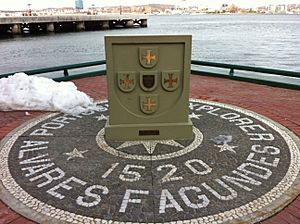João Álvares Fagundes facts for kids
Quick facts for kids
João Álvares Fagundes
|
|
|---|---|

Fagundes commemorative beside Halifax Harbour, Nova Scotia.
|
|
| Born | c. 1460 Viana do Castelo, Kingdom of Portugal
|
| Died | December 1522 Viana do Castelo, Kingdom of Portugal
|
| Occupation | Explorer, ship-owner |
| Known for | Expeditions to Newfoundland and Nova Scotia |
João Álvares Fagundes (born around 1460 in Kingdom of Portugal, died 1522 in Portugal) was an explorer and ship owner. He came from Viana do Castelo in northern Portugal. He is famous for leading several trips to explore parts of Newfoundland and Nova Scotia around 1520–1521.
Fagundes explored many islands with his second captain, Pêro de Barcelos. They were joined by colonists, mostly from the Azores and some from mainland Portugal. They explored islands like St Paul near Cape Breton, Sable Island, and Funk Island (which was called Penguin Island back then). They also visited Burgeo and Saint Pierre and Miquelon. Fagundes named the latter islands the "Eleven Thousand Virgins" to honor Saint Ursula.
On March 13, 1521, King Manuel I of Portugal gave Fagundes special rights. These rights meant he owned the lands he discovered.
In 1607, another explorer named Samuel de Champlain found an old, mossy cross. It was located at what is now Advocate Harbour, Nova Scotia. Some historians believe this cross was left by Fagundes. They think he visited that spot about 80 years earlier.
A Portuguese Fishing Colony
Some historical reports suggest that João Álvares Fagundes tried to start a colony. In 1570, Captain Francisco de Souza from Madeira reported on this. He said that about 45 or 50 years earlier, some noblemen from Viana wanted to settle in the "New Land of the Codfish."
They got permission from King Manuel for an expedition. Fagundes led this trip with several families and couples. Many of them were from the Azores, especially Terceira. They sailed to North America with a large ship (a nau) and a smaller one (a caravel).
Where the Colony Was Located
The colonists found Newfoundland too cold. So, they sailed west until they found a new coast. This coast ran from northeast to southwest. They settled there, but their ships were lost or ran out. After that, no one in Portugal heard from them for a long time.
Later, Basque fishermen who visited the area brought news. They told stories about the colony and its people. The Basques said the colonists wanted Portugal to know their situation. They also asked for priests. The local people, possibly the Mi'kmaq, were described as "peaceful and docile."
According to Souza, this settlement was in "Cape Britão," which is Cape Breton today. It was in a beautiful bay on the north coast. The area had valuable things, walnuts, chestnuts, grapes, and other fruits. It seemed like a good place to live. Some couples from the Azores had settled there.
The Fate of the Colony
The governor of Madeira hoped that help could reach the colonists. This possible colony might have lasted until the 1570s or even longer.
See also
 In Spanish: João Álvares Fagundes para niños
In Spanish: João Álvares Fagundes para niños

